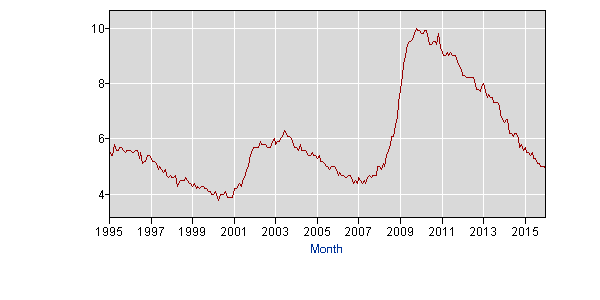In the most recent Democratic debate, Hilary Clinton said, “Americans haven’t had a raise in 15 years.” I’ll talk more about that in a second. Other candidates of both parties are getting votes and dominating polls by playing on our current national fears. For some, it is security fears; for others it’s economic fears. On the economic front, Bernie Sanders blames the 1% richest Americans. Donald Trump blames Mexican immigrants and Muslims. To the degree that they’re all correct that job prospects for young people are worse than they’ve been in a while and wages have stagnated for all Americans, no politician has named the single biggest contributor to this reality: the U.S. healthcare system.
First let’s get our facts straight. Non-partisan non-profits such as the Pew Research Center have concluded that wages have indeed remained flat over the last 15 years, adjusted for inflation. So let’s assume Mrs. Clinton was correct, but let’s dive deeper. These numbers are only for the people who actually have jobs.
The latest official unemployment rate is listed as 4.9%, but the deeper reality is that since the recession of 2008, a lot of adults simply gave up looking for jobs. From the Bureau of Labor Statistics (BLS), here are a series of graphs illustrating the problems.
First, here is the official unemployment rate since 1995 (The U-3 data from the BLS website).
 But here is the unemployment rate if we include everyone who wants to have a job, but might have given up looking for a few months. This rate is 9.9%, which is the same as the peaks of the recessions of 1995 and 2004 (The U-6 data from the BLS website).
But here is the unemployment rate if we include everyone who wants to have a job, but might have given up looking for a few months. This rate is 9.9%, which is the same as the peaks of the recessions of 1995 and 2004 (The U-6 data from the BLS website).
 Here are the numbers of Americans who say they want a job. Again, the current number is down from the post-2008 recession peak, but still high historically.
Here are the numbers of Americans who say they want a job. Again, the current number is down from the post-2008 recession peak, but still high historically.
 And here are the percentages of working-age adults in the workforce: still hasn’t recovered from the recession.
And here are the percentages of working-age adults in the workforce: still hasn’t recovered from the recession.
 What’s to blame for this? For starters we can all admit our love for cellphones shows no boundaries. According to the BLS, “consumer unit” (which more or less means an average household) spending on cellphones jumped 57% since 2007 ($963 in 2014). The good news is that this increase was somewhat offset by the decrease in residential phone expenses:
What’s to blame for this? For starters we can all admit our love for cellphones shows no boundaries. According to the BLS, “consumer unit” (which more or less means an average household) spending on cellphones jumped 57% since 2007 ($963 in 2014). The good news is that this increase was somewhat offset by the decrease in residential phone expenses:
 Educational debt is another huge contributor to those Americans who have gone to college. It now stands at about $1.2 Trillion, second only to home mortgage debt, which works out to an average of $29,000 each distributed over 40 million borrowers.
Educational debt is another huge contributor to those Americans who have gone to college. It now stands at about $1.2 Trillion, second only to home mortgage debt, which works out to an average of $29,000 each distributed over 40 million borrowers.
But let’s explore this a little further. Why is student debt so high? It’s because about 50 years ago states spent about 5% of their budgets on healthcare: for state employees and Medicaid costs. Now it’s over 30% (if the health benefits costs of the state employees are included, which they often are not on basic state spending reports). If states are spending more on healthcare, they have less to spend on fixing potholes, maintaining state parks, and helping pay for the tuition costs for university students. Thus, student loan debt goes up.
I think an important concept missing from reports such as Pew is that it doesn’t fully include the cost of healthcare. According to more BLS data, of out-of-pocket healthcare costs has risen faster than inflation over the last 20 years. It’s averaged about 5% per year, while the general inflation rate has averaged about 2.1% over the same timeframe.
The percent of the total healthcare bill households pay each year has actually stayed at a fairly fixed percentage over the last 20 or so years. It feels to employees like that they are paying a bigger share, but what they don’t see is the annual inflation for health insurance paid for by their employers. The inflation rate is about the same. Economists at RAND Corporation published a study in 2009 that calculated that 79% of U.S. workers’ increased productivity over the preceding decade got siphoned off to healthcare costs. More recent data give us no reason to think this situation has improved.
To wrap this up, probably the single biggest inflationary pressure on the cost of healthcare in the last 5-10 years has been pharmaceuticals, particularly cancer drugs, which commonly increase life expectancy by about 2-4 months at a cost of about $100,000 per treatment. So the next time you see a Cancer Treatment Centers of America commercial, instead of imagining you or a loved one travelling to one of their facilities for cancer treatment, say to yourself, “That’s where my job went.”



Recent Comments